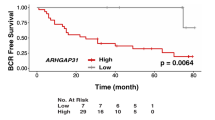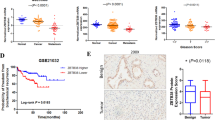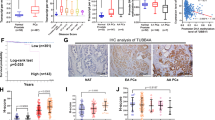Abstract
C17orf37/MGC14832, a novel gene located on human chromosome 17q12 in the ERBB2 amplicon, is abundantly expressed in breast cancer. C17orf37 expression has been reported to positively correlate with grade and stage of cancer progression; however the functional significance of C17orf37 overexpression in cancer biology is not known. Here, we show that C17orf37 is highly expressed in prostate cancer cell lines and tumors, compared to minimal expression in normal prostate cells and tissues. Cellular localization studies by confocal and total internal reflection fluorescence microscopy revealed predominant expression of C17orf37 in the cytosol with intense staining in the membrane of prostate cancer cells. RNA-interference-mediated downregulation of C17orf37 resulted in decreased migration and invasion of DU-145 prostate cancer cells, and suppressed the DNA-binding activity of nuclear factor-κB (NF-κB) transcription factor resulting in reduced expression of downstream target genes matrix metalloproteinase 9, urokinase plasminogen activator and vascular endothelial growth factor. Phosphorylation of PKB/Akt was also reduced upon C17orf37 downregulation, suggesting C17orf37 acts as a signaling molecule that increases invasive potential of prostate cancer cells by NF-κB-mediated downstream target genes. Our data strongly suggest C17orf37 overexpression in prostate cancer functionally enhances migration and invasion of tumor cells, and is an important target for cancer therapy.
This is a preview of subscription content, access via your institution
Access options
Subscribe to this journal
Receive 50 print issues and online access
$259.00 per year
only $5.18 per issue
Buy this article
- Purchase on Springer Link
- Instant access to full article PDF
Prices may be subject to local taxes which are calculated during checkout






Similar content being viewed by others
Accession codes
References
Aguirre Ghiso JA, Kovalski K, Ossowski L . (1999). Tumor dormancy induced by downregulation of urokinase receptor in human carcinoma involves integrin and MAPK signaling. J Cell Biol 147: 89–104.
Arya M, Bott SR, Shergill IS, Ahmed HU, Williamson M, Patel HR . (2006). The metastatic cascade in prostate cancer. Surg Oncol 15: 117–128.
Axelrod D . (2001). Selective imaging of surface fluorescence with very high aperture microscope objectives. J Biomed Opt 6: 6–13.
Banerjee AG, Liu J, Yuan Y, Gopalakrishnan VK, Johansson SL, Dinda AK et al. (2003). Expression of biomarkers modulating prostate cancer angiogenesis: differential expression of annexin II in prostate carcinomas from India and USA. Mol Cancer 8: 2–34.
Berger R, Lin DI, Nieto M, Sicinska E, Garraway LA, Adams H et al. (2006). Androgen-dependent regulation of her-2/neu in prostate cancer cells. Cancer Res 66: 5723–5728.
Burghardt TP, Ajtai K, Borejdo J . (2006). In situ single-molecule imaging with attoliter detection using objective total internal reflection confocal microscopy. Biochemistry 45: 4058.
Chan TO, Rittenhouse SE, Tsichlis PN . (1999). AKT/PKB and other D3 phosphoinositide-regulated kinases: kinase activation by phosphoinositide-dependent phosphorylation. Annu Rev Biochem 68: 965–1014.
Connolly JM, Rose DP . (1998). Angiogenesis in two human prostate cancer cell lines with differing metastatic potential when growing as solid tumors in nude mice. J Urol 160: 932–936.
Das S, Roth CP, Wasson LM, Vishwanatha JK . (2007). Signal transducer and activator of transcription-6 (STAT6) is a constitutively expressed survival factor in human prostate cancer. Prostate 67: 1550–1564.
Eeles RA, Kote-Jarai Z, Giles GG, Olama AA, Guy M, Jugurnauth SK et al. (2008). Multiple newly identified loci associated with prostate cancer susceptibility. Nat Genet 40: 316 .
Evans EE, Henn AD, Jonason A, Paris MJ, Schiffhauer LM, Borrello MA et al. (2006). C35 (C17orf37) is a novel tumor biomarker abundantly expressed in breast cancer. Mol Cancer Ther 5: 2919.
Fresno Vara JA, Casado E, de Castro J, Cejas P, Belda-Iniesta C, Gonzalez-Baron M . (2004). PI3K/Akt signalling pathway and cancer. Cancer Treat Rev 30: 193–204.
Fu HW, Casey PJ . (1999). Enzymology and biology of CaaX protein prenylation. Recent Prog Horm Res 54: 315.
Helenius MA, Savinainen KJ, Bova GS, Visakorpi T . (2006). Amplification of the urokinase gene and the sensitivity of prostate cancer cells to urokinase inhibitors. BJU Int 97: 404–409.
Hicklin DJ, Ellis LM . (2005). Role of the vascular endothelial growth factor pathway in tumor growth and angiogenesis. J Clin Oncol 23: 1011–1027.
Huang S, Pettaway CA, Uehara H, Bucana CD, Fidler IJ . (2001). Blockade of NF-kappaB activity in human prostate cancer cells is associated with suppression of angiogenesis, invasion, and metastasis. Oncogene 20: 4188–4197.
Jo M, Thomas KS, Marozkina N, Amin TJ, Silva CM, Parsons SJ et al. (2005). Dynamic assembly of the urokinase-type plasminogen activator signaling receptor complex determines the mitogenic activity of urokinase-type plasminogen activator. J Biol Chem 280: 17449–17457.
Kauraniemi P, Kallioniemi A . (2006). Activation of multiple cancer-associated genes at the ERBB2 amplicon in breast cancer. Endocr Relat Cancer 13: 39.
Kelly P, Stemmle LN, Madden JF, Fields TA, Daaka Y, Casey PJ . (2006). A role for the G12 family of heterotrimeric G proteins in prostate cancer invasion. J Biol Chem 281: 26483–26490.
Li Y, Cozzi PJ . (2007). Targeting uPA/uPAR in prostate cancer. Cancer Treat Rev 33: 521–527.
Lokeshwar BL . (1999). MMP inhibition in prostate cancer. Ann NY Acad Sci 878: 271–289.
Maurer-Stroh S, Eisenhaber F . (2005). Refinement and prediction of protein prenylation motifs. Genome Biol 6: R55.
Myers RB, Srivastava S, Oelschlager DK, Grizzle WE . (1994). Expression of p160erbB-3 and p185erbB-2 in prostatic intraepithelial neoplasia and prostatic adenocarcinoma. J Natl Cancer Inst 86: 1140–1145.
Pienta KJ, Loberg R . (2005). The ‘emigration, migration, and immigration’ of prostate cancer. Clin Prostate Cancer 4: 24–30.
Price JT, Bonovich MT, Kohn EC . (1997). The biochemistry of cancer dissemination. Crit Rev Biochem Mol Biol 32: 175.
Rothermund CA, Kondrikov D, Lin MF, Vishwanatha JK . (2002). Regulation of bcl-2 during androgen-unresponsive progression of prostate cancer. Prostate Cancer Prostatic Dis 5: 236.
Sheng S . (2001). The urokinase-type plasminogen activator system in prostate cancer metastasis. Cancer Metastasis Rev 20: 287–296.
Sliva D . (2004). Signaling pathways responsible for cancer cell invasion as targets for cancer therapy. Curr Cancer Drug Targets 4: 327.
Suh J, Rabson AB . (2004). NF-kappaB activation in human prostate cancer: important mediator or epiphenomenon? J Cell Biochem 91: 100–117.
Sun J, Zheng SL, Wiklund F, Isaacs SD, Purcell LD, Gao Z et al. (2008). Evidence for two independent prostate cancer risk-associated loci in the HNF1B gene at 17q12. Nat Genet 40: 1153–1155 .
Thalmann GN, Anezinis PE, Chang SM, Zhau HE, Kim EE, Hopwood VL et al. (1994). Androgen-independent cancer progression and bone metastasis in the LNCaP model of human prostate cancer. Cancer Res 54: 2577.
Virtanen SS, Vaananen HK, Harkonen PL, Lakkakorpi PT . (2002). Alendronate inhibits invasion of PC-3 prostate cancer cells by affecting the mevalonate pathway. Cancer Res 62: 2708–2714.
Wilson MJ, Sinha AA . (1993). Plasminogen activator and metalloprotease activities of Du-145, PC-3, and 1-LN-PC-3-1A human prostate tumors grown in nude mice: correlation with tumor invasive behavior. Cell Mol Biol Res 39: 751–760.
Wilson SR, Gallagher S, Warpeha K, Hawthorne SJ . (2004). Amplification of MMP-2 and MMP-9 production by prostate cancer cell lines via activation of protease-activated receptors. Prostate 60: 168–174.
Winter-Vann AM, Casey PJ . (2005). Post-prenylation-processing enzymes as new targets in oncogenesis. Nat Rev Cancer 5: 405–412.
Woolard J, Wang WY, Bevan HS, Qiu Y, Morbidelli L, Pritchard-Jones RO et al. (2004). VEGF165b, an inhibitory vascular endothelial growth factor splice variant: mechanism of action, in vivo effect on angiogenesis and endogenous protein expression. Cancer Res 64: 7822–7835.
Wu HC, Hsieh JT, Gleave ME, Brown NM, Pathak S, Chung LW . (1994). Derivation of androgen-independent human LNCaP prostatic cancer cell sublines: role of bone stromal cells. Int J Cancer 57: 406–412.
Acknowledgements
We thank Dr Linda Cunnighum (UNTHSC) for assistance with immunohistochemistry and Dr Kapil Mehta (MD Anderson Cancer Center, TX) for help with migration assays. The present work is supported by grant nos. CA109593 and MD 001633 (JKV) from NIH and DOD PCRP Training Award PC081282 (SD). UNMC/Eppley Cancer Center Tumor Bank was supported by an NCI Cancer Center Support Grant P30 CA36727 and Nebraska Department of Health Institutional LB595 Grant for Cancer and Smoking Disease Research.
Author information
Authors and Affiliations
Corresponding author
Additional information
Supplementary Information accompanies the paper on the Oncogene website (http://www.nature.com/onc)
Rights and permissions
About this article
Cite this article
Dasgupta, S., Wasson, L., Rauniyar, N. et al. Novel gene C17orf37 in 17q12 amplicon promotes migration and invasion of prostate cancer cells. Oncogene 28, 2860–2872 (2009). https://doi.org/10.1038/onc.2009.145
Received:
Revised:
Accepted:
Published:
Issue Date:
DOI: https://doi.org/10.1038/onc.2009.145
Keywords
This article is cited by
-
MIEN1, a novel interactor of Annexin A2, promotes tumor cell migration by enhancing AnxA2 cell surface expression
Molecular Cancer (2015)
-
MicroRNA-940 suppresses prostate cancer migration and invasion by regulating MIEN1
Molecular Cancer (2014)
-
The interaction between C35 and ΔNp73 promotes chemo-resistance in ovarian cancer cells
British Journal of Cancer (2013)
-
A gene on the HER2 amplicon, C35, is an oncogene in breast cancer whose actions are prevented by inhibition of Syk
British Journal of Cancer (2010)
-
Resonance assignments of human C35 (C17orf37) protein, a novel tumor biomarker
Biomolecular NMR Assignments (2010)



